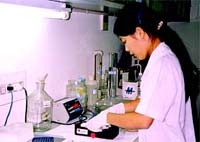H5N1 virus has had high toxicity mutations
The Pasteur Institute in Ho Chi Minh City has completed and reported to the Ministry of Science and Technology on the project of "Research on decoding of A H5N1 influenza virus genome in Vietnam on human and poultry diseases".
 According to the study (from March 2004 to March 2005) of the molecular biology department, Pasteur Institute in Ho Chi Minh City, 24 samples of the virus were decoded. In it, there are 16 virus samples on poultry, waterfowl and five virus samples on human being completely decoded. Virus samples were taken from infected human and poultry specimens in the southern region during the epidemic period from December 2003 to March 2005. The decoding showed that all pandemic viruses were still the most common Z-type H5N1 virus of the region since 2004.
According to the study (from March 2004 to March 2005) of the molecular biology department, Pasteur Institute in Ho Chi Minh City, 24 samples of the virus were decoded. In it, there are 16 virus samples on poultry, waterfowl and five virus samples on human being completely decoded. Virus samples were taken from infected human and poultry specimens in the southern region during the epidemic period from December 2003 to March 2005. The decoding showed that all pandemic viruses were still the most common Z-type H5N1 virus of the region since 2004.
However, the study of the detection of the H5N1 strain of human, poultry and waterfowl in early 2005 had serious mutations, focusing on the key functional areas of the avian influenza virus gene, especially on those surface antigens (HA, NA) and sites that determine hosts as well as areas of virulence regulation (in genes HA, PB2, NS).
There was a mutation in PB2 gene that allowed the virus to reproduce effectively in mammalian cells and highly toxic. At the same time, the occurrence of viral strains in fatal patients with many mutations occurred in all genes.
These are signs that the virus has been integrating mutations to adapt to new hosts and increase toxicity, the community may face the spread of H5N1 from human to human. It is noteworthy that all Vietnamese strains in the study have mutations resistant to Amantadine and Rimantadine antiviral drugs. Therefore, it is necessary and urgent to monitor the virus resistant to oseltamivir (Tamiflu) as well as to store new effective antiviral drugs .
According to this study, simultaneous decoding of the entire genome of the isolated virus from patients and poultry will provide more complete information about the A H5N1 strain of influenza circulating in Vietnam.
However, Dr. Cao Bao Van - head of molecular biology of Pasteur Institute in Ho Chi Minh City, and the chairman of this research project - said that mutations that allow viruses to spread from person to person have not been confirmed. Because there are still some questions to answer: the virus can accumulate mutations to create a human-adapted variant, or a genetic recombination with a human influenza virus that needs to be Prerequisites for forming a pandemic virus strain?
Adaptation of avian influenza virus to people who need intermediate hosts? Do genetic changes coincide with increased toxicity?
LE THANH HA
- H5N1 virus increases toxicity
- The discovery of five mutations in H5N1 determines the spread
- H5N1 flu appears in poultry in Ninh Thuan
- 5 mutations make bird flu a pandemic
- Detection of the H5N1 virus strain by a test
- Restart studies of H5N1
- H5N1 virus is evolving
- Cats infected with H5N1 virus?
- IAEA uses nuclear technology against H5N1 virus
- WHO announces the study of variant H5N1 avian influenza virus
- H5N1 avian influenza virus
- Mutations in H5N1 in Turkey
 March 2012: Launching H5N1 vaccine for poultry
March 2012: Launching H5N1 vaccine for poultry Experts comment on the mysterious gradual disappearance of the Delta variant in Japan
Experts comment on the mysterious gradual disappearance of the Delta variant in Japan Danger of the two Delta . branch variants
Danger of the two Delta . branch variants 2020 pandemic flu attack humans?
2020 pandemic flu attack humans? Why can't the flu virus be eradicated?
Why can't the flu virus be eradicated?  Garlic does not kill coronavirus
Garlic does not kill coronavirus  Does the corona virus stick to clothes, shoes, hair, papers?
Does the corona virus stick to clothes, shoes, hair, papers?  Top 10 things doctors recommend for living with SARS-CoV-2
Top 10 things doctors recommend for living with SARS-CoV-2  Vaccines to prevent future strains of Corona virus
Vaccines to prevent future strains of Corona virus  What you need to know about the virus that has a 70% mortality rate in India
What you need to know about the virus that has a 70% mortality rate in India 